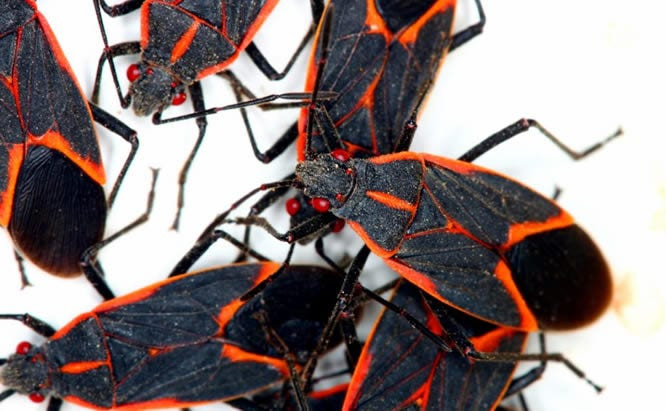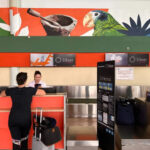Boxelder bugs are a common nuisance for homeowners, particularly in certain regions. As fall approaches, these insects often congregate in large numbers on homes, seeking warmth and shelter. Their sheer numbers can be alarming, raising questions about their behavior and how to manage them. One frequent question is: Can Boxelder Bugs Fly? Let’s delve into this and other key aspects of boxelder bugs to better understand these persistent pests.
What Exactly Are Boxelder Bugs?
Boxelder bugs, scientifically known as Boisea trivittatus, are native insects in the western United States. They are notorious for becoming a significant problem during late summer and fall when they search for places to spend the winter. During this period, it’s common to see them clustered on the sunny sides of trees and buildings. Adult boxelder bugs are relatively small, about half an inch in length, with distinctive orange or red markings on their black bodies. They are sometimes mistakenly called box elder beetles or maple bugs and are often confused with stink bugs due to their similar flat, oval shape. It’s worth noting that squashing them is not advisable as it releases an unpleasant odor and can stain surfaces.
 Boxelder Bugs
Boxelder Bugs
So, Can Boxelder Bugs Fly?
Yes, boxelder bugs are indeed capable fliers. In fact, they are considered strong and agile fliers, often traveling considerable distances – sometimes several miles – from their hatching sites on trees. This ability to fly is crucial for them as they search for food sources and suitable overwintering locations. Their mobility explains why they can suddenly appear in large numbers around homes, even if boxelder trees are not immediately present.
Do Boxelder Bugs Bite or Sting?
While their appearance might be unsettling, boxelder bugs are not known to bite in the typical sense. They are classified as “true bugs,” meaning they possess mouthparts designed for sucking fluids rather than biting and chewing. Occasionally, they might prick skin with their sharp mouthparts, possibly in defense or exploration, but this is rare and not considered a bite. Furthermore, boxelder bugs are not equipped with stingers and cannot sting.
Are Boxelder Bugs Harmful to Pets?
If you have pets that are curious about insects, it’s best to discourage them from snacking on boxelder bugs. As a defense mechanism, these bugs are reported to have a very unpleasant taste. If a dog eats a boxelder bug, it might experience vomiting shortly after. It’s wise to take your dog outside or confine it to an easily cleaned area if you suspect it has ingested a boxelder bug. Some dogs might also drool excessively. Cats may be slightly more tolerant of boxelder bugs, but they can still experience similar reactions like vomiting or excessive salivation. If you are concerned about your pet’s health after it has encountered a boxelder bug, consulting your veterinarian is always a good precaution.
What Do Boxelder Bugs Eat?
Boxelder bugs are plant feeders, using their sucking mouthparts to extract juices from plants. Their primary food source is the seeds of boxelder trees, as well as other maple species. Despite sometimes appearing in large numbers on these trees, boxelder bugs generally cause minimal damage to the trees themselves. They are more of a nuisance due to their presence around homes than for the harm they inflict on vegetation.
Do Boxelder Bugs Emit an Odor?
Under normal circumstances, boxelder bugs do not produce any noticeable smell. However, when they are disturbed or crushed, they release a pungent, foul-tasting compound as a defense against predators. This defensive odor, along with their bright orange or red coloration, serves as a warning signal to potential predators to avoid them. This effective defense mechanism allows boxelder bugs to congregate in large, exposed groups without significant threat from being eaten.
Where Do Boxelder Bugs Lay Their Eggs?
Boxelder bugs lay their eggs on their host trees – specifically on the trunks, branches, and leaves of boxelder and maple trees. They do not lay eggs inside homes or other structures. After hatching from eggs in about 10 to 14 days, the nymphs undergo five molting stages throughout spring, summer, and fall as they grow and mature.
What Attracts Boxelder Bugs?
Boxelder bugs are naturally drawn to their food source: the seeds of maple trees. In spring, they feed on juices from fallen, ungerminated seeds. As summer progresses, they feed on developing seeds. Beyond food, boxelder bugs are also attracted to places that offer shelter for the winter. In natural environments, they seek refuge under rocks, in hollow logs, and beneath loose bark. Human-made structures also provide excellent shelter, with boxelder bugs often found behind siding or in wood piles. They are also attracted to warm surfaces, often congregating on south- or west-facing walls made of brick or stucco that receive ample sunlight.
Why Are Boxelder Bugs So Noticeable in the Fall?
The increased visibility of boxelder bugs in the fall is due to their changing behavior as the weather cools. During spring and summer, multiple generations of boxelder bugs develop. As temperatures drop, their survival instincts kick in, and they actively search for winter shelter, often attempting to enter buildings. This mass movement towards homes and buildings makes their presence much more apparent. They seek entry through cracks, crevices, damaged window screens, ventilation ducts, and utility and plumbing penetrations.
How Can Boxelder Bugs Be Controlled? Getting Rid of Boxelder Bugs
Managing boxelder bugs, especially when they are numerous, can seem like a big task. However, several straightforward steps can reduce their presence and prevent them from entering your home:
- Eliminate Food Sources: If feasible, removing female boxelder trees (maples that produce seed pods) can reduce the local boxelder bug population. Since they primarily feed on these seeds, removing the source can deter them from your yard.
- Seal Entry Points: Boxelder bugs can squeeze through very small openings, as tiny as 1/8 inch. Seal cracks and gaps in your home’s foundation, around windows and doors, and where utilities enter using caulk or foam sealant. Install door sweeps on exterior doors.
- Repair or Install Screens: Inspect window and door screens for any tears or holes and repair them. Ensure ventilation openings, including dryer, heating, and air conditioning vents, and soffits, are screened to prevent entry.
Alt text: Container of TERRO® Ant Dust, a product recommended for outdoor boxelder bug control.
For more significant infestations, consider using insecticidal products designed for boxelder bug control. TERRO® offers various solutions to help manage boxelder bug problems both indoors and outdoors.
Are Boxelder Bug Infestations Worse This Year?
If you are experiencing a significant boxelder bug problem this year, you are not alone. Many factors can influence boxelder bug populations each year, and some years may indeed see larger numbers.
If you’re dealing with a large number of boxelder bugs, consider sharing your photos on social media! You can visit TERRO® on Facebook to post pictures and ask further questions about boxelder bugs. For more informative articles and links to TERRO® products, consider subscribing to their eNewsletter.
